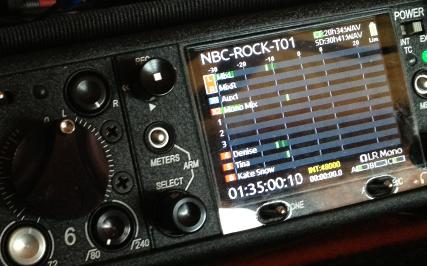Sound Devices 664 |
|
After several weeks now of working with the 664 I’ve put together a more thorough look at its real capabilities and functionality which in my world is dominated by bag work on a substantial level. First off, it is important to understand just what the 664 is, it is a machine designed to excel in the fast paced world of extreme bag work. To attempt to portray the 664 as a mixer that, oh by the way, can record some files is utterly false. Not only will it quickly and easily provide full mix track capabilities via the aux send but it will do TWO easily assigned mixes via both aux sends created from different inputs relative to what your cameras are shooting. What does this mean? Well it means you can get a headache running the scenarios in your head. Example: Mono mix hops to cameras with aux 1 feeding 'A' cam and aux 2 feeding 'B' cam with camera mics on respective channel 2’s. The left/right outs are feeding the producer IFB feeds which can also be tailored by dropping channels out of the L/R bus. (Improper use of IFB but that’s the lingo) 'A' camera decides it needs an interview and heads off to the side with cast member in tow while 'B' camera continues to roll on normal action. Post wants proper mix on each camera whenever possible with iso track backups and you’re alone. I should also note that both aux mixes are fully recorded as well as the ISOs. 'B' camera mix is Aux 2 so you drop the departing cast member from the Aux 2 mix by right selecting the channel PFL switch and change the routing option and repeat for Aux 1 to tailor 'A' cams new cast line up. Grab your head phone selector switch and roll to your pre-saved HP user setting (1 of 6) which is aux 1 in the left ear and aux 2 in the right using the PFL’s to pop in and out of any iso listening you need which includes simultaneous ISO monitoring of as many channels as you’d like to combine. Since you are running all your inputs to the aux buses post fader you have full and total mix capabilities to both sends while your ISO’s are being happily recorded via your normal gain structure. It’s a lot more then just a mixer and this is just one example of the options available when you approach a shoot. ----- So far I have created 2 of the 4 internally stored user setups. First up is my ‘ENG Base’, which simply immediately recalls the most common setup I use for general bag work. Things like all my redundant sound report info and basic channel names/power configuration. The second is my ‘Live IFB’ setup, which assumes my input 5 and Aux 2 are dedicated IFB with the corresponding output/input level shifts. It is truly noteworthy that with each saved setup you have 6 headphone presets as well as your list of track names. All that info stays with each setup. An example is that in my ‘Live IFB’… I have an HP preset that is left/right but with the addition of aux 2 (IFB) added to the right ear. That preset does not appear in my ‘ENG Base’ which is free to create 6 pre-sets of its own. With the recent firmware version 1.02 we gained a shortcut for the space bar which increases the track naming/data input speed dramatically. At the completion of a shoot I save my settings to the SD card and when I house the files on a hard drive the complete 664 settings are stored with the original files and can be reloaded in seconds as well as emailed to another mixer with a 664. ----- As a recorder it excels with very slick card options to choose from and the ability to tailor just what you want recorded where. When you put the 664 into record you have very distinct tone indicators in your cans and the file name and timecode are encased in a bright red box. There is no doubt that you are recording. There is also no doubt that the files you are recording are of the highest quality and it would be a hard sell indeed to convince me otherwise. ----- Three camera interviews with transcription are the norm in my world. Making the A,B & C outputs/returns just a great part of my everyday life. I record transcription on one of the aux buses which even allows me to add a “dead mic” of an off camera interviewer simply for transcription. Now on a crash that same method is employed but expanded by feeding the aux send via telephone live to the transcription house. Typically I’d run that through a JK Audio That-2 or Remote MixC+.
Op Ed… The point here is that the 664 is an incredibly flexible machine capable of handling the most rigorous of recording demands and is designed to excel from the point of view of the bag. I’ve been really surprised at all the online pontificating about it. Mostly from the standpoint of attempting to minimize its impact on the industry and paint it as an inferior product when the opposite is true. In my opinion, with absolutely no inside information, Sound Devices will launch a new cart based recorder at NAB 2013 completing a retooling of their audio recorder line.
We’ll see! But I for one am thrilled that the 664 is not a 788T.
Thom Shafer |
||
 |
||
Home ----- Tech Tips ----- Sound Devices 664 ----- Contact Me |
|
www.televisionsound.com / Thom Shafer |
|